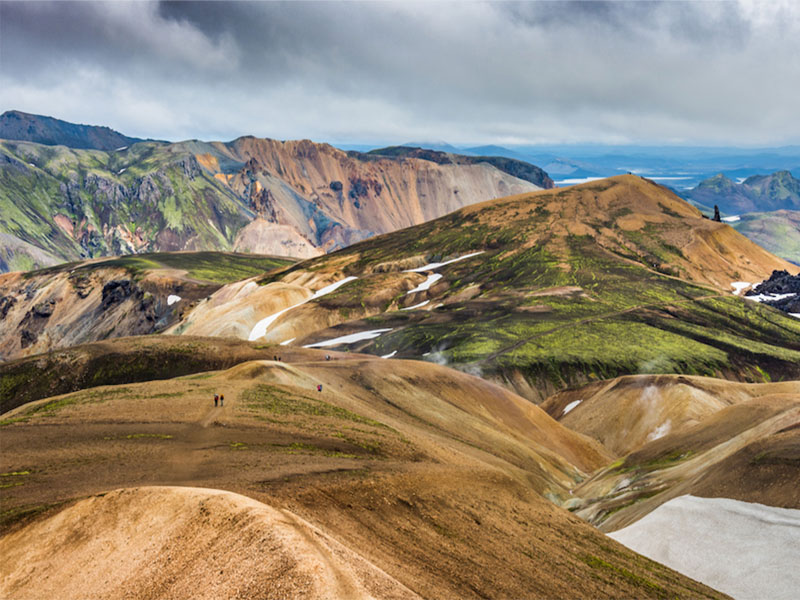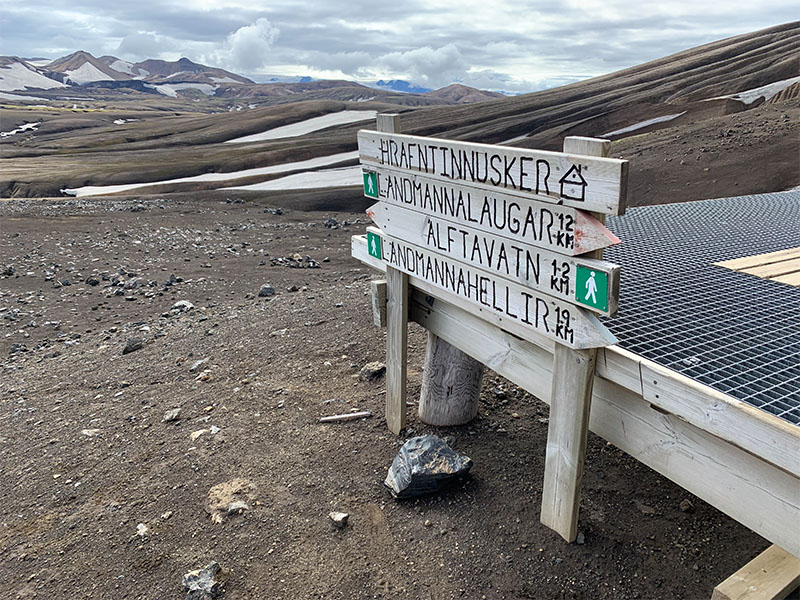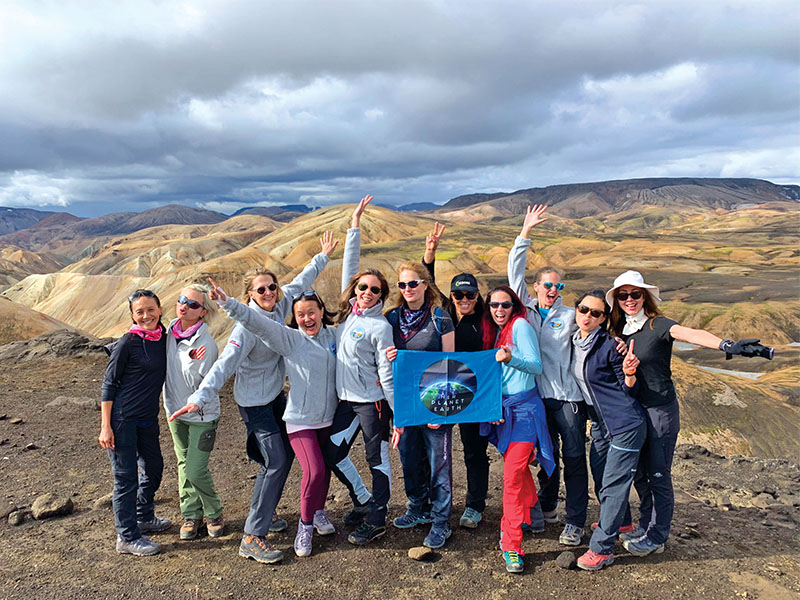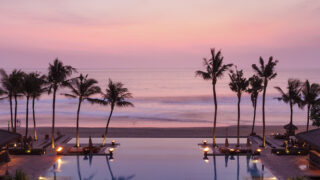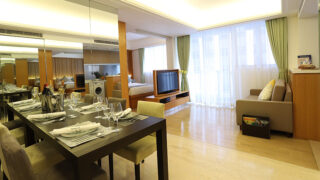CHRISTINE AMOUR-LEVAR recounts her adventures with the HER Planet Earth team across the out-of-the-world landscapes of Iceland.
Landing in Iceland makes you feel like you’re arriving at the very edge of the world. For avid trekkers, this place is paradise because of the incredibly rich topography and varied landscape. Known as the Land of Fire and Ice, it has stunning blue glaciers, black sandy deserts, over 130 volcanoes, obsidian lava fields, multi-coloured snow-capped mountains, and explosive geysers.
A geographical oddity
Indeed, Iceland’s very existence is a geographical oddity. It marks the point where the European and American tectonic plates meet, and are pushed apart by volcanic activity, making it one of the most geologically active places on earth. Iceland is also the most sparsely populated country in Europe; it’s twice the size of Sri Lanka, yet with a population of just 360,000. The first permanent settlement wasn’t established until AD 874, when a Norse Viking Chieftain called Ingólfr Arnarson arrived off the coast with his family. According to local lore, he threw two carved pillars overboard, vowing to set up home where they landed. The pillars washed ashore on a coastline dotted with steam vents; he called the place Reykjavik, which means “bay of smoke” in Norse. His settlement is still the capital today, and home to two thirds of Iceland’s tiny population.
The team and the mission
It’s August 2019, towards the end of the Icelandic summer, and our team of 12 women – part of HER Planet Earth, an Asia-based NGO that promotes female empowerment and environmental conservation (HERplanetearth.com) – touches down in Reykjavik. Most of us live in Singapore or Hong Kong; only one has set foot in Iceland before
The journey ahead is exciting, and we look forward to spending five days traversing one of the country’s most active, volcanic and alien landscapes: Laugavegur, a trail in the Southern Highlands, originally formed by an eruption in 1477.
The changing climate
We chose Iceland because it’s already feeling the brunt of climate change. Land here is rising at an average of 3.5 centimetres per year in certain areas. This is because, as the country’s glaciers melt, it reduces pressure on the land below, causing the surface to rise. This changing geography is another tangible showcase of the effects of global warming.
Iceland recently held an actual funeral for the first glacier “killed” by climate change – the 700-year-old Okjokull. If a glacier melts and becomes too thin, it stops moving, and is then declared dead. Glaciers have great cultural significance here; funerals are part of the mourning process, and reveal a strong human connection with nature. Tragically, at current rates of warming, all the country’s glaciers will suffer Okjokull’s fate in the next 200 years, one by one.
Our determined team is using this expedition to raise awareness and funds for underprivileged women affected by climate change. We want to highlight that gender often remains the untold story. Indeed, in many countries, women are among the most vulnerable to climate change and environmental degradation, partly because they make up the larger share of the agricultural workforce and tend to have access to fewer income-earning jobs. While climate change is a global phenomenon, its effects are felt locally, and poor people suffer the most – among the world’s 1.3 billion poor people, the majority are women.
Exploring “Middle Earth”
After a bone-shattering three-hour drive east of Reykjavik on a rough dirt road, we reach our first camp in the late afternoon, at the start of the Laugavegur trail. The area is only open to trekkers from June to August; the rest of the year, the weather is too ferocious to risk hiking.
As we step out of the van and breathe in the crisp six-degree-Celsius air, it’s easy to forget this is the middle of summer. Nevertheless, the camp has a great surprise in store for us – a natural geothermal hot spring for bathing in!
This first evening, the group is in high spirits. In the summer, Iceland never really gets dark, so we’re tempted to stay up late, despite the early start the next morning. But the trail awaits.
Considered one of the world’s finest walking routes because of its staggering beauty and diversity, Laugavegur ranks right up there with the Inca Trail in Peru and New Zealand’s Milford Track.
We set out the next day under clear blue skies, and as soon as we step out of camp, we are greeted by the most extraordinary, heart-stopping landscapes. The hills are breathtakingly barren and coloured 50 shades of brown. As we climb higher, the wind starts to bite.
This place makes you feel as if you’re a character in The Lord of the Rings. It’s no accident that JRR Tolkien was fascinated by Iceland. They say this part of the country is as close as you’ll ever get to Middle Earth, the fantasy land he describes in his novels.
As the day progresses, we make our way to the heart of this geothermal wonderland, with stunning scenery at every turn: incredible lunar surfaces, volcanic rocks, majestic waterfalls and steaming hot geysers with their bubbling sulphuric acid pools.
Respecting the landscape
Our respect for the landscape grows deeper with every step. It’s the location’s otherworldly quality that has brought NASA to Iceland on numerous occasions to train astronauts. The geological conditions are similar to those encountered on the Moon and Mars. And, since people in Iceland live mainly on the coastal fringe, you can walk for miles inland and see no sign of human life – no roads, no houses, nothing.
In the thousand years since Iceland has been inhabited, there have been over 250 eruptions in a volcanically active zone covering a quarter of the country. Our trail runs through the heart of this zone, so it’s not a hike for the faint of heart.
We soon come across a sobering reminder of why never to underestimate the risk of being in mountains. It’s a memorial for a young Israeli man – just a modest pile of stones, with a metal plaque that says: “In loving memory of Ido Keinan who passed away in a blizzard so close to the safe hut nearby yet so far, at only 25 years. June 27, 2004.” It’s frightening to read about, and to learn that the tragedy took place at the height of summer.
Just a few hundred metres later, we reach the Hrafntinnusker campsite for lunch. Throughout the trek, we camp outdoors. The climate ranges from beautiful sunny days, to cold, windy and rainy spells, with temperatures around five to six degrees, for the most part. We hike about 10 hours per day, and the team is relieved and joyous when, at the end of each day, we finally reach our campsite for the night, with the promise of warm food and rest.
Descending into the valley
The landscape is ever changing. Descending into the valley, we go from slopes covered in electric green moss, to lunar landscapes and artic trails, before entering a thick fern and birchwood forest called Thorsmork, named after the Norse God of Thunder.
As we hike through the woods, our intrepid, experienced guide Helga, shares a tale with us. “We do have trolls who live in these mountains,” she says. “They only come down to forage for food at night. If they’re caught in the sunlight, they immediately turn to stone.” It seems the majority of Icelanders believe in – or at least refuse to deny the existence of – elves, trolls and other hidden beings.
Worsening weather
On the third day, the weather catches up with us. The showers come and go as we march on through black volcanic rock covered with a thick layer of dust and sand.
This isn’t any ordinary dust. This is the stuff that caused chaos all over Europe when, in 2010, a volcano under the Eyjafjallajokul ice cap began erupting for the first time since the 1820s. It spewed ash 9,000 metres into the air (higher than Everest) and caused the largest international airspace shutdown in years.
On our last day, conditions worsen. The weather closes in and becomes quite menacing, quite fast. The wind and rain are relentless and intensify in strength. This forces us to seek shelter and plan for an early evacuation, as galeforce winds of over 50kph start battering the mountains.
Despite the poor conditions, Iceland has drawn us in. The team has covered close to 80km of undulating mountainous terrain, crossing numerous freezing rivers in the processes and enduring unpredictable and capricious micro-climates. The whole experience is surreal, and for many of us almost spiritual. The stunning beauty and dramatic lunar landscapes of Iceland have kept us transfixed throughout the journey.
What’s more, pushing our limits for a very worthy cause has made the whole experience even more meaningful; we are bonded in our sisterhood and in our common goal. The team returns home with an unforgettable impression of this truly wild and awe-inspiring place.
See more in our Travel section.
Subscribe to Expat Living magazine now so you never miss an issue.

